Newsletter No.66
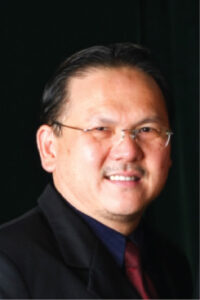

I would like to take this opportunity to wish all our Muslim members and friends SELAMAT HARI RAYA AIDIL FITRI.
31st july marked the 26th MAFAAS Annual Meeting which was held in Nibong Tebal, a small town near to the border of Perak and Penang. All the key office bearers and representatives from both the Alumni from PAAM and ABK-Penang attended the meeting. For the first time it was conducted at a private residence, the home town of our Treasurer, Mr. KT Khor. We would like to thank KT san and his family for playing host for the meeting. The meeting was held with “family bond” atmosphere, with lots of friendly exchange of information and sharing of ideas to formulate new directions that will benefit both societies. We are committed and I believe many of the joint projects will soon be realized.
In conjunction with the MAFAAS meeting, our social committee took the opportunity to organize a social outing to visit the Gua Tempurung, Gopeng, a popular tourist spot which is not far from Ipoh. The following day a group of 24 of us including family members had the opportunity to visit durian orchard where everyone was given the chance explore the 10 acres site farmland which is owned by KT san family. Everyone really had a good time and had lots of fun to experience the hand-on plucking of fruits from the trees and not forgetting savouring the great “king & queen of fruits” durian and rambutan. It was indeed a memorable trip.
On a sad note, we received news from PAAM Sabah Branch of the demised of their Chairman Mr. Chong Tze Kong on 23rd July 2010. Our deepest condolences to all family members of the late Mr. Chong.,/p>
Mr. Tetsuo Tojo from the Embassy of Japan in Malaysia paid a courtesy visit to our office on 4th August. The purpose of his visit was to have a better understanding of PAAM and its activities. We shared lots of information on our activities and on the year-plan and what was expected as host for the forthcoming AOTS-Alumni World Convention in Kuala Lumpur. We are thankful to the Embassy for their strong support and generous sponsorship in many of our events and activities.
For the first time, Mini Tanabata Matsuri was jointly organized with Hippo Family Club at the Japan Club in Kuala Lumpur on 15th August 2010. Thanks to Ms. Maggie Yap and her committee for having organized this eventful gathering. A group of young Malaysian and Japanese participated and shared in the colorful and joyful event.
The school project on 5S/kaizen had finally found a “home” base at SMK Seafield at Subang Jaya on 26th July. The program kicked off with the sharing of the basic principles on good housekeeping and discipline of 5S/Kaizen. Two sessions had so far been conducted for the teaching staff and pupils from the lower sixth former. I strongly believe this will be great success looking at their enthusiasm and keen participation.
31st August marked the 53rd Anniversary of our Merdeka Day celebration. We are proud to be Malaysian and having able to see so much of achievements and with the development soon to be a developed nation in year 2020. It is our hope that there will be peace and prosperity in years ahead.
Wishing everyone good health and happiness always.
President
CL Yang. PJM
Two years had passed since the handover of the Chairmanship of the Malaysian Federation of AOTS-ABK Alumni Society (MAFAAS) to Persatuan Alumni AOTS Malaysia (PAAM). On 31st July 2010, at a meeting held in Nibong Tebal, where PAAM handed back the MAFAAS Chairmanship to Pertubuhan Alumni ABK/AOTS(PAAA) for the next years.
Four representatives from PAAM, Mr. Yang Chor Leong, Mr. Tan Teng Ek, Ms. Maggie Yap Cheng Hong and Mr. Khor Kai Tong together with four PAAM observers Mr. Yap Choon Ming, Mr. Siao Kent Wah, Ms. Angela Sunny Saul and Ms Haslinda Yahya attended the 26th MAFAAS Meeting while PAAA representatives were Ms. Rachel Wong Lai Cheun, Mr. Lau Eng Hwa, Mr. Chuah Theong Chen and Ms. Melina Tay Wah Sim.
The Committee discussed various issues and explored the possibilities of holding joint venture activities.
 |
Mr. Yang (PAAM) handing over MAFAAS Chairmanship to Ms. Rachel (PAAA |
A training program on Japanese Approach to Quality Management (QM) for Profitability was held on 6th & 7th July 2010, at the Crystal Crown Hotel, Petaling Jaya. The training was conducted by Encik A Aziz Y Kamaruddin, who has 22 years of experience in the field of Quality Management.
The 17 participants came from Percetakan Surya Sdn Bhd, Sumitomo Electric Sintered Components (M) Sdn Bhd, APM Plastics Sdn Bhd, Teraju Sinar Sdn Bhd, J.K. Wire Harness Sdn Bhd and Teck See Plastic Sdn Bhd and Toto Malaysia Sdn Bhd.
Among the Lecture Topics covered were The Deming Chain Reaction, Statistical Process Control (SPC), QM Practices in Japanese Companies and Motivation. Exercises included Cost Savings, and Market Gains (to show how profitability is achieved), and Group Dynamics (to show how teamwork leads to better decision-making).
Some of the positive (written) comments received from the participants were “This program should be great for top Management level”, and “This program is very good. Follow it up”.
We would like to thank the participants for their excellent commitment, exemplary time-discipline and active participation during the training program.
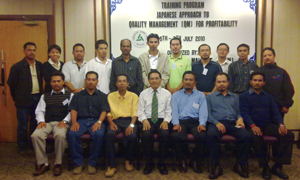 The program participants with Encik A Aziz Y Kamaruddin (sitting – center) | |
 Participant keenly engrossed in group discussions | 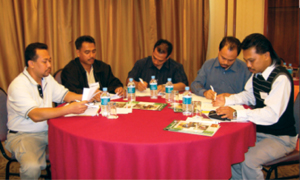 |
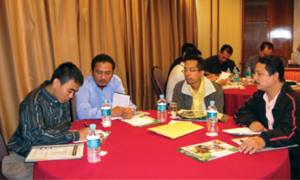 | |

 Name:
Name:
Mr. Khor Kai Tong
Background
Mr. Khor attended PMAE-4 training in YKC, Yokohama (1991) and ENFT training in KKC, Nagoya (1996). After attending PMAE-4 training course, he actively involved himself in PAAM activities, first as a member of PME/Entrepreneurship sub-committee for 4 years and later as a member of the Central Committee until today.
Currently he holds the post of Honorary Treasurer, having served in this position for the past 3 terms (2002 to 2008). He was Assistant Treasurer (2008 to 2010).
Career
Mr. Khor is a business owner and his company Pacific Deluxe Sdn Bhd., incorporated in 1993, deals with all types of Fire Protection Engineering installation for factories, high-rise buildings and aircraft hangers, include overseas project (Sri Lanka and Maldives Island).
He was in this field for 35 years since 1975 and was head of division for manufacturing of fire fighting equipments for 5 years before starting his own company.
Family
Married and blessed with three children, a son aged 24, 2 daughters aged 23 & 17 years old respectively.
5S is a methodology that uses a list of five Japanese words which are seiri, seiton, seiso, seiketsu and shitsuke.
Translated into English, they all start with the letter S. The list describes how items are stored and how the new order is maintained. Whereas Kaizen (Japanese for “improvement” or “change for the better”) refers to philosophy or practices that focus upon continuous improvement of processes in manufacturing, engineering, supporting business processes, and management.
Yung Kong (YK) staff has been honored to be given the opportunity to attend training on the first steps towards betterment – 5S & Kaizen conducted by Mr. Lim Eng Swee from Persatuan Alumni AOTS, Malaysia.
Mr. Lim graduated from Kyoto University of Japan, with his vast experience in the Japanese multinational corporation, conducted a 3 days training in Wisma Hii Yii Ngiik, Kuching from 15th to 17th June 2010. The launching of the program was graced by Mr. Victor Hii, Executive Director of Yung Kong Galvanizing Industries (YKGI).
The training was well received by more than 80 participants from various YK group of companies. Participants also indicated that the training was very satisfying and the knowledge received will be of great help to their work and operations.
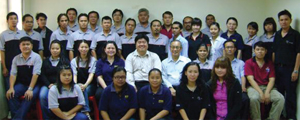 |  |
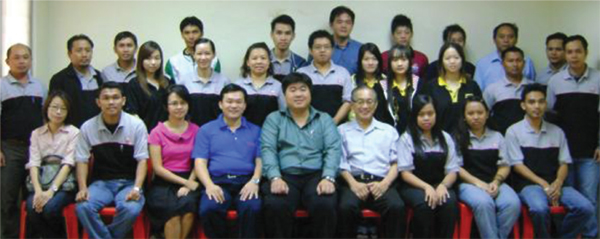
On 17th July 2010 (Thursday), Persatuan Alumni AOTS Malaysia (PAAM) and The Technological Association of Malaysia (TAM) committee members visited a LCD TV assembly factory in Shah Alam, Teraju Sinar Sdn Bhd.
The group was warmly welcomed by Mr. A C Kua, the Managing Director of the company. The group was given a very interesting tour of the factory, witnessing first-hand how LCD TVs being assembled. The tour ended with lunch hosted by the Managing Director.
We wish to take this opportunity to thank Mr. Tan Teng Ek for his kind efforts to help to organize this meaningful factory visit.
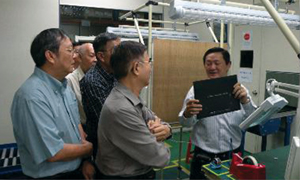 |
 |
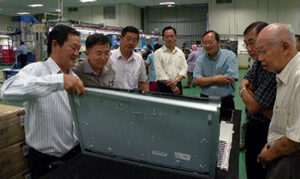 |
 |
Photos show the group being briefed on the technicalities of assembling LCD TVs by the MD and Managers of Teraju Sinar Sdn Bhd, Shah Alam

A friend asked me an excellent question: ‘If milk is not healthy, pray tell why butter (milk based) is better than margarine (palm oil based)?’ I forgave him (because it was the holy fasting month, and furthermore he prays even when asking nutrition questions), because margarine is made from plant oils such as rapeseed (now guys…please don’t be unduly excited), sunflower etc, not only palm.
My strong recommendation, if you are really interested in your health: Go read ‘Toxic Trans Fat in Processed Foods’ by Consumer Association of Penang (RM7.00).
I remember that it was ‘cool’ (and smart?) in the 1970s (well, I am from the baby boomer generation), for me to use margarine instead of butter for my toast. Butter has high saturated fats, and excessive consumption increases blood cholesterol, and is said to cause heart disease (that will be another story!). Margarine contains unsaturated fat, and therefore considered healthy (for the heart).
The problem is this: to make margarine from plant oils, the liquid oils have to be hydrogenated to turn it into semi-solid margarine. The process creates… voila! … trans fat (also called trans fatty acid)!
What are trans fatty acids, and what are their physiological effects?
A trans fatty acid differs from its (chemically identical formula) cis fatty acid through the different spatial arrangement of its molecules (thus creating two isomers). The different spatial arrangements (made possible by the presence of a double bond in unsaturated fatty acids) produce two different distinct products with different properties. Trans fatty acids usually arise from hydrogenation (e.g. in production of margarine from vegetable fat), or heating at high temperatures (as in frying), of cis fatty acids.
Trans fatty acids create a physiological problem because our body’s enzyme systems for handling fatty acids are specifically designed to efficiently handle only cis fatty acids. Because of the similar chemical formula (but different properties), the trans fatty acid is able to attach itself to an enzyme surface (at its active point); but it is not able to be transformed – becoming a powerful enzyme inhibitor. This therefore prevents the normal metabolism of our healthy cis fatty acids. Essential fatty acids are precursors of important hormones which control metabolic and physiological processes; blockage of their production at the enzyme level (that conducts these transformations) therefore will have serious and incapacitating effects on our health. Being of an awkward configuration (shape), trans fatty acids also disrupt the membrane structure of cells.
In simple layman’s language, what the above ultimately means is that trans fat is linked to: breast (guys, please … dont’ get excited) cancer, lower quality of breast milk, decreased insulin response (not good for diabetics), raised bad LDL cholesterol (doubles the risk of heart attack), decreased testosterone and increased abnormal sperm (in animals, phew…that was close), etc. The US National Academies’ Institute of Medicine concluded (in 2002) that the only safe level of trans fat in the diet is zero.
Thank you for your interest in your health. Hasta la vista.
azizyoup@hotmail.com
It was a fine morning when a group of 24 young, old and senior members and friends took off from Klang Valley to Gua Tempurung on 31st July 2010. The group consisted of PAAM members, and family members and friends of PAAM members.
Taking off in five cars, our group left Petaling Jaya at about 9.00am and arrived safely at Gua Tempurung, Gopeng, Perak approximately 3.00 pm, after stopping at Tanjung Tualang, Kuala Selangor for a lazy sea food lunch.
Gua Tempurung is a beautiful tourist spot with pristine caves and unspoiled flora/fauna with crystal-clear underground river running right underneath. The place was very well maintained but unfortunately not as well publicized. Hence on the day that we visited there, the crowd at Gua Tempurung was not that big.
Later in the evening, our group drove further up to Jawi, Seberang Perai to stay overnight. The next morning before coming back we headed for a durian orchard where we had our fill of durians and many types of local fruits before packing up for home-sweet-home.
All in all, it was a good experience for all of us as we had the opportunity to get away from the hustle and bustle of city life and go back to nature for a whiff of fresh air, tranquility and adventure.


Participants were then asked to assemble Hikoboshi and Orihime on prepared cut origami. Everybody had some cute versions of Hikoboshi and Orihime. Wishes and dream words were written on Tanzaku paper. Finally, the participants hung prepared colourful stars, Hikoboshi, Orihime and Tanzaku to the balloon stick. Wow, all these personal handicrafts were later given to all the participants as souvenir for remembrance.
Tanabata song was played and participants heartily sang along, as Romanized Japanese lyrics with English translation were distributed to help them.
After the group photo, light Japanese refreshments was served and everyone has time to get to know each other and then we bid each other sayonara till we meet again in 2011.
15th August 2010 is a memorable day for 45 participants who experienced the first Tanabata Festival ever jointly organised by PAAM and Hippo KL. Held in Japan Club, the bare function room was beautifully transformed to give Japanese ambience, with real bamboo plants and colourful origami in the shape of bamboo leaves and other decorations.
Graced by Mr Tojo, Advisor from the Japan Embassy, the event kicked off with a short welcome speech delivered by Mr Yang, the PAAM President.
The Tanabata Matsuri event commenced with London Bridge and Biribiri PonPon as ice breakers. Everyone was having fun with the games.
Narrated in Japanese and English, the Tanabata story was portrayed with pictorial characters displayed on the curtain.
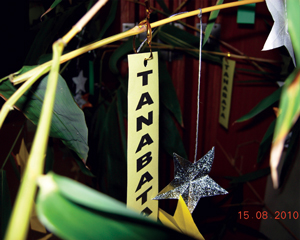 |
 |
 |
 |
 |
 |

The Japanese people are very good at exchanging words of encouragement. The word often used is GANBATTE which means good luck or try your best.
GANBATTE comes from the word Ganbaru which means “to hold out or to persevere in doing something.”
Sometimes kudasai is added. So it becomes GANBATTE KUDASAI. In this case it means a request from the speaker to “Please try your best” or “Please persevere in whatever you are doing”.
Ganbatte kudasai has variations such as ganbare, ganbare-yo and ganbatte-ne.
In a baseball game, the Japanese would shout out “Ganbare” to encourage their favorite team. Another form of using Ganbatte kudasai is Ganbare-yo especially when they want to encourage you to study hard to do well in a coming examination.
“ima gambarenai yatsuwa, isshou gambarenai”
Those who not doing his best right now, wont do his best EVER.


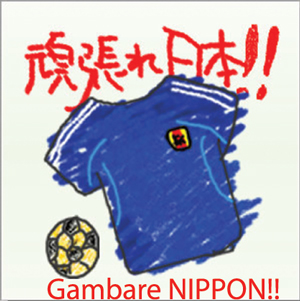



Following are examples of common expressions that can be found in conversations. A little practice in the fundamentals will go a long way and it will make your conversation more exciting.
1.Target Phrases
Iku tsumori desu. I intend to go.
2.Iku tsumori dattan desu.
I had intended to go.
Example
Kim: Yoshida san, tashika konya wa konsetto ni ikutte ittemashita ne.
Mr Yoshida, you were saying that you’ll go to the concert this evening, weren’t you?
Yoshida: Ee! Iku tsumori desu ga, nanika……?
Yes, I intend to, but is there anything….?
Example 2
Chan : Kinoo no konsetto, ikaga deshita ka.
How was yesterday’s concert?
Yoshida: Sore ga, iku tsumori dattan desu ga, kyuu ni ikenakunarimashite…
Actually, I had intended to go, but I was suddenly unable to.
Dear Readers,
How are you getting along with Katakana Shiken?
I hope the exercises will help you in understanding how loanwords are written and spoken. We will continue with a few more exercises and we hope you will have fun decoding whenever you encounter with loanwords written in Katakana.
Loanwords are foreign words adopted into the Japanese language. The spelling and the pronunciation may differ from the original but I think you just need a little time and patience and in no time you will be skillful in decoding Katakana.
The following quiz will make it fun for the early learners to begin learning Katakana. Match the Katakana to their English equivalent. Use the blank column to decode.
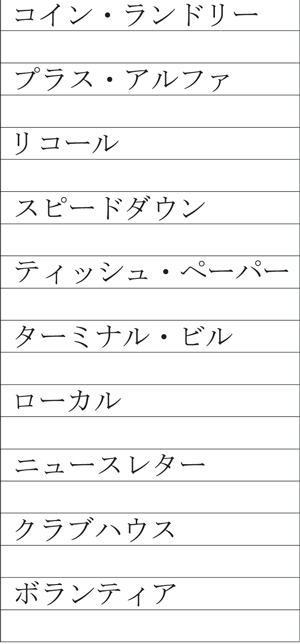
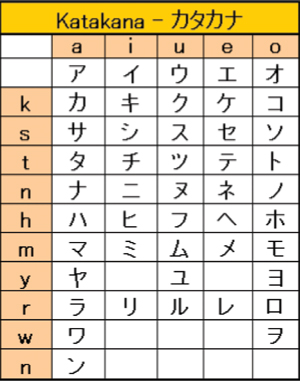
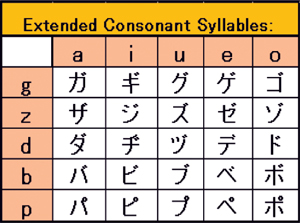
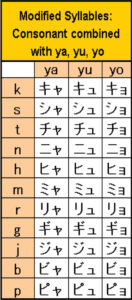
Mr. Shipango Muteto presenting a momento to Mr. Yang
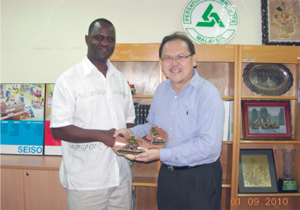  |